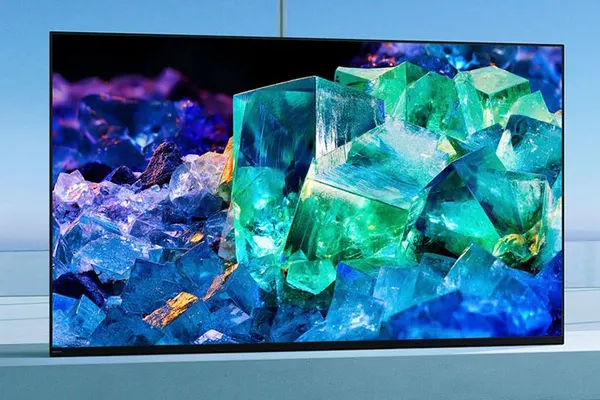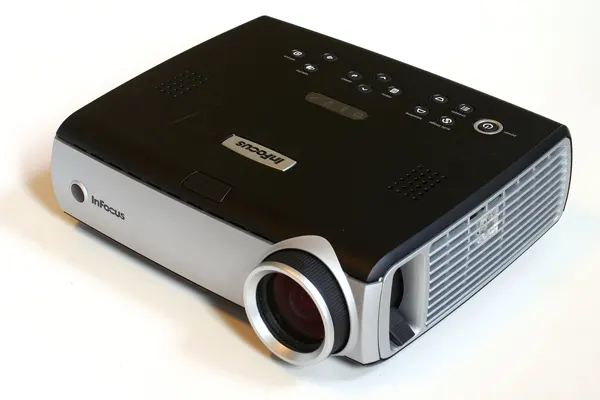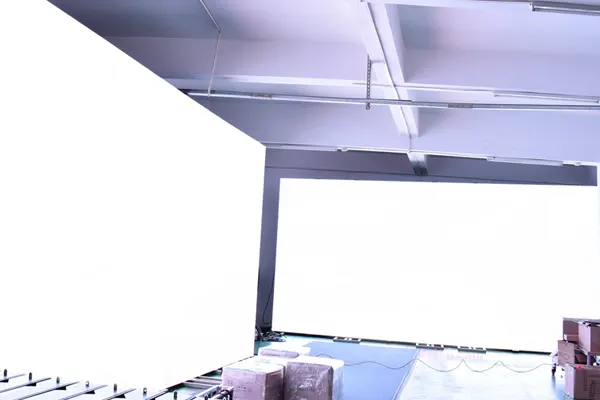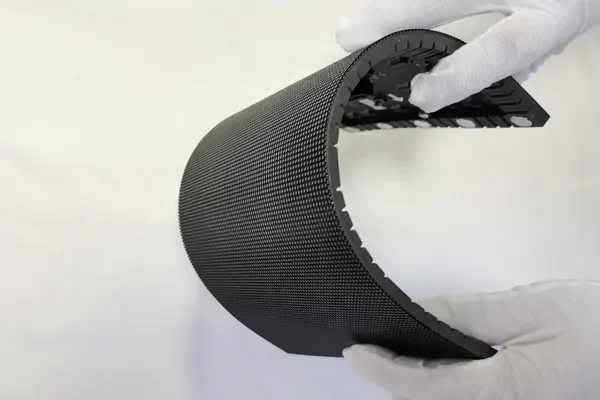LED displays and projectors are two commonly used gadgets in our world. In this post, we will compare these two devices. How do they work? What are their types? On what features do these devices differ from each other?
What is a projector?
It is an optical output device. It projects the content or image onto a surface. The surface can be large, flat, or lightly colored. A computer or Blu-ray player generates the content. The projector reproduces this content onto the surface. We can call it a projection screen. There is a small transparent lens in most of the projectors. The projectors produce the image by shining the light through this lens. Nowadays, some projectors use lasers for projection.
The most common type is a video projector. A typical projector is the size of a toaster. It weighs only a few pounds. We use projectors in various fields. It has almost become a gadget of everyday use. Some of its standard services are:
- Show a presentation in a meeting
- Project a PC screen to teach a class
- Watch a movie with a projector playing on a large screen.

What is an LED display?
It is a display screen technology that uses light-emitting diodes. These diodes act as a light source. These LEDs are the real unsung heroes of the display world. You would have already heard that it is a semiconductor device. Such a device can conduct electricity. An LED display consists of the following parts:
- LED display module
- Power supply
- Cabinet
- Control card
- Cooling fan
- Power and signal connector
- Video processor
LED displays have the following characteristics:
- Long service life
- Reliability
- High-quality visual experience
- Environment friendly
- High photoelectric conversion efficiency
- Low driving voltage
- User-friendly
- Vast applications

History of projector:
There were opaque projectors in the early and mid-20th century. They were low-cost toys for children. The light source in these projectors was the limelight. After this, the light source was incandescent light bulbs and halogen lamps.
In the 50s and 60s, schools and businesses had overhead projectors. Police used the first such projector for identification work. The United States used it in 1940. After that, they used it in quantity for training.
After this came the slide projectors. From the 1950s to the 1990s, they were common for presentations. They were also a form of entertainment, especially for movies.
From the 70s to the 90s, complex multi-image shows used sliding projectors. They use 35 mm and 46 mm transparency slides. In 1990, digital cameras became commercial. It resulted in a change from 35 mm slides to digital images. In 2004, the production of Kodak Carousel slide projectors stopped. In 2009, the manufacturing and processing of Kodachrome films stopped.
History of LED display:
The light-emitting diodes came into being in 1962. Nick Holonyak made the first practical LED. For the first decade, it was mainly red. Hewlett Packard HP made the first functional LED display in 1968. This display was the first to use integrated circuit technology. It was a massive development in the field of display screens. It became the basis for later progress LED displays.
In the late 1980s, the blue LED arrived. Former displays were primarily monochromatic. Then, aluminum Indium Gallium Phosphide LEDs came into existence in the late 1980s. But we were still not able to achieve the full color.
The critical development came with Mark Fisher’s design for U2’s PopMart Tour of 1997. He found that we could achieve large images due to two things.
- Long viewing distance
- Wide pixel spacing
It took three decades for Sony to produce the OLED TV. Finally, in 2011, the UEFA Champions League Final was broadcast on a 3D LED display. MicroLED displays are currently in development.

How does the projector work?
There is a lens in the projector. The light goes through the lens. Then it magnifies an inverted image on the wall. I will explain the working of the projector with an example. You make a small hole in the cardboard. You place a light source through this hole. There will be hole-shaped light on the wall. The same is the case with the projector’s working.
How does the LED display work?
Photons are units of light. Fast-moving electrons release the photons. When current passes through the diodes, the electrons combine with holes. As a result, they emit light. As discussed above, the diode is a semiconductor device. Thus, they can conduct electricity.
A display screen has thousands of closely packed light-emitting diodes. There are three types of diodes known as RGB.
- Red LEDs
- Green LEDs
- Blue LEDs
These three colors are enough to produce any color we have. These three colors mix to form a pixel. The display can create thousands of colors. It can do so by adjusting the intensity of diodes. When we look at the screen, the array of colored pixels appears as images.

Types of projectors:
Depending upon the technology used, we have the following types of projectors:
- Cathode ray tube projector
- Liquid crystal display projector
- Digital light processing projector
- Liquid crystal on silicon projector
- LED projectors
- Laser projectors
Cathode ray tube projector:
We also call these projectors gun projectors. The technology used in them is the same as that used in CRT television. Besides, there is the light magnifying lens. In addition, there are three high-brightness cathode ray tubes. These components effectively work to generate an image.

Source: Reddit
Liquid crystal display projector:
It consists of three panels made of glass and liquid crystals. Besides, there are five mirrors. Out of five, three are regular mirrors. In contrast, the other two mirrors are dichroic. The dichroic mirrors split white light into red, blue, and green colors. At this principle, such projectors work.

Source: Quora
Digital light processing projector:
It is more advanced than the human eye. It can process an image with up to 35 million colors. It consists of digital micro-mirror device chips.

Source: Wikipedia
Liquid crystal on silicon projector:
These are the latest type of projectors in the market. They have characters of both projectors, LCD and DLP. But, unlike DLP projectors, they use liquid crystal on a reflective silicon backplate.

Source: Wikipedia
LED projector:
They use light-emitting diodes to generate light. They do not use traditional projectors lamp. For magnification, they can use LCD or DLP technology.
Laser projector:
As the name indicates, this type of projector uses a laser to generate an image. Laser is the light source rather than traditional bulbs. They can use other technologies like DLP, LCD, or LCOS.
Types of LED displays:
Though there are many ways to classify LED displays, we will choose the most common one. We will divide them based on the environment they are present. Based on the environment, we have three types of LED displays which include:
- Outdoor LED display
- Indoor LED display
- Semi-outdoor display
Outdoor LED display:
These screens need much planning before manufacturing. We all know we have to deal with natural phenomena for outdoor setups. So we have to make them resistant to harsh weather conditions. The outdoor LED displays are water and moisture-proof. Moreover, they are also wind resistant.
In these displays, luminance intensity is of great importance. The brightness level for outdoor screens is 4,000-7,000 nits or more. It is high enough to make the content visible even in blazing sunlight. Advertisement via billboards is also its domain.

Indoor LED display:
The name suggests its application. These LED displays are specifically for indoor setups. So they are different in characters which we observe in outdoor LED displays. An essential feature in which they differ is brightness. Indoor LED screen brightness is low. It is because the surrounding luminance is less. And we can see the content displayed even at low brightness. There is also no sealed waterproof function in these screens.
These screens also differ in size. Indoor LED displays are relatively smaller than outdoor LED displays. Their viewing distance is only a few meters.

Semi-outdoor LED display:
Semi-outdoor displays do not have distinct features. They have elements of both indoor and outdoor LED screens. We usually find their application at:
- Open halls
- Under eaves
- Beneath sunroofs
- Under canopy
These semi-outdoor screens have the same brightness level as outdoor screens. But these displays do not have the same protective features.
Besides these types, there are numerous other kinds of LED displays. These depend on the display screen’s features, technology, and application.
Difference between the projector and LED display:
Here we will discuss the features that differ between the projector and LED displays.
- Brightness
- Picture quality
- Flexibility
- Cost and maintenance
- Life span
Brightness:
We all know there are outdoor and indoor LED displays. The diodes used in them have a solid and effective source of light. The light emitted by these diodes is strong enough to withstand the sunlight. As a result, the picture is less affected by the sunlight. So, the image is quite evident even in the outdoor setup.
But if we talk about projectors, the case is different. Projectors work well when there is dim light in the surrounding. But, the surroundings affect the brightness of the projectors. Thus, it can lose its luminance.
In some other aspects, the brightness of LED displays and projectors varies. For a projector to work well, we need an unobstructed path. There should be no hindrance between the light source and the display. Otherwise, the image becomes distorted. But it is not the case with LED panels. In the case of LEDs, the light source is on the screen. Thus, the light tends to emit from the screen. Therefore, there is no limitation of any obstruction in the path of the light source.
The brightness of the LED display is 3.426 times that of the projector. We measure the brightness of the LED display in nits. The average brightness value for an LED display is 600 nits or above. At this value, it can work well regardless of the ambient light in the surrounding.
Picture quality:
There is no comparison of picture quality between both. It is because both technologies maintain resolution and picture quality. High-quality projectors and LED displays have similar performance. It is because both setups can manage high resolution.
The projectors are well known for their best definition. But for LED displays, we cannot deny the fact that they offer the highest resolution. It is because a surface mount diode in an LED display gives the highest definition.
For projectors, we have a limitation on the surface on which we will project light. The white surface does not give off dark tones. Due to this, the image looks out of focus. So, for the high definition, we need a good contrast level. LED display will allow light to come out with high contrast. It is because there is less light dissipation. So, we have the edge of high contrast for LED display, which gives the best image quality.
The projectors tend to enlarge the image without compromising its quality. For LED displays, the case is the same; we can make large screens by integrating small LED panels. But there is some edge in the point of LED displays. LED displays offer high-contrast images, which is lacking in the case of projectors.
Flexibility:
LED displays and projectors are flexible and have great features in this regard. As a result, their application is relatively easy. But LED displays are more flexible than projectors.
LED displays have LED panels that are paper thin. So they are easy to move. Moreover, we can make any size of screen out of them. So, we have the advantage of installing them at any place. There are also curved LED screens which increase its flexibility.
For projectors, we need majorly two leading pieces of equipment.
- A projector
- Matte screen
In the case of projectors, we have flexibility in terms of installation. But there is a limitation of the unimpeded surface. So at this point, the flexibility of projectors got compromised. So we need an unobstructed path between the projector and the screen.

Cost and maintenance:
This part has a much more critical role in any technology. The cost of the equipment you will install is of great significance.
In most cases, the cost of LED displays is more than the price of projectors of the same quality. But there are many options for quality features and size.
If we compare both setups in terms of maintenance, we have an advantage in the case of LED displays. LED displays need less upkeep as compared to projectors. LED display requires significantly less servicing and repair. In contrast, project bulbs and light engines need replacement routinely.
LED displays offer less expenditure of energy. They consume about half of the power as compared to projectors.
Life span:
LED displays have a good life span as compared to projectors. The longevity of most good quality projectors cannot combat that of LED displays. You can better understand the following life spans:
- For medium LED display: 7-10 years
- For industrial quality projectors: 3 years
The reason behind this huge difference in longevity is the light source. The projectors emit all of their light and heat from one concentrated place. Due to this, the electrical components degrade at a faster rate.


